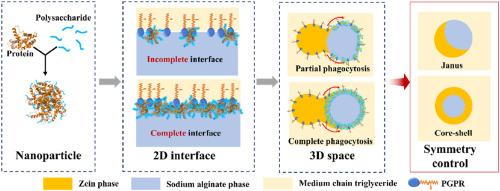Precise control of biphasic droplet symmetry: Nanoparticle-mediated 2D interfacial engineering modulates 3D spatial configuration
IF 11
1区 农林科学
Q1 CHEMISTRY, APPLIED
引用次数: 0
Abstract
Differences in the spatial arrangement of two immiscible phases lead to variations in the symmetry of biphasic droplets, thereby endowing them with diversified 3D spatial configurations. Symmetric core-shell droplets and asymmetric Janus droplets play crucial roles in the food field, including applications in protective encapsulation, controlled release, autonomous motion, particle synthesis, and more. However, comprehending and elucidating the control mechanism of biphasic droplet symmetry in one-step emulsification process remains a daunting challenge. The collision and coalescence behaviors of zein droplets and sodium alginate droplets in 3D space, similar to phagocytosis, create opportunities for the formation of biphasic droplets and the precise control of their symmetry. The interactions between immiscible droplets are closely linked to their 2D interfacial structure. Nanoparticles are utilized as an effective tool to control integrity of 2D interface in monophasic droplets. Therefore, the protein–polysaccharide nanoparticles, fabricated through deamidation and the Maillard reaction, are utilized to regulate the properties of the sodium alginate droplet 2D interface. Variations in the 2D interface structure of the sodium alginate droplets lead to the complete or incomplete engulfment of the sodium alginate droplets by the zein droplets. Ultimately, the nanoparticle-mediated 2D interface engineering modulates 3D spatial configuration of biphasic droplets. This work employs dimensionality reduction theory, using a 2D interface as an anchor point, to achieve symmetry control of biphasic droplets through nanoparticles. It not only lays theoretical foundations for applications of biphasic droplets but also introduces a new research paradigm for the design of functional food colloid structures.

精确控制双相液滴对称:纳米粒子介导的二维界面工程调节三维空间结构
两相不混相空间排列的差异导致双相液滴对称性的变化,从而使其具有多样化的三维空间构型。对称核壳液滴和不对称Janus液滴在食品领域发挥着至关重要的作用,包括在保护性封装,控制释放,自主运动,颗粒合成等方面的应用。然而,理解和阐明一步乳化过程中双相液滴对称的控制机制仍然是一个艰巨的挑战。玉米蛋白液滴和海藻酸钠液滴在三维空间中的碰撞和聚并行为,类似于吞噬作用,为双相液滴的形成和对其对称性的精确控制创造了机会。不混相液滴之间的相互作用与其二维界面结构密切相关。纳米粒子是控制单相液滴中二维界面完整性的有效工具。因此,通过脱酰胺和美拉德反应制备的蛋白质-多糖纳米颗粒被用来调节海藻酸钠液滴二维界面的性质。海藻酸钠液滴的二维界面结构的变化导致海藻酸钠液滴完全或不完全被玉米蛋白液滴吞没。最终,纳米粒子介导的二维界面工程调节了双相液滴的三维空间构型。本研究采用降维理论,以二维界面为锚点,通过纳米颗粒实现双相液滴的对称控制。这不仅为双相液滴的应用奠定了理论基础,而且为功能性食品胶体结构的设计引入了新的研究范式。
本文章由计算机程序翻译,如有差异,请以英文原文为准。
求助全文
约1分钟内获得全文
求助全文
来源期刊

Food Hydrocolloids
工程技术-食品科技
CiteScore
19.90
自引率
14.00%
发文量
871
审稿时长
37 days
期刊介绍:
Food Hydrocolloids publishes original and innovative research focused on the characterization, functional properties, and applications of hydrocolloid materials used in food products. These hydrocolloids, defined as polysaccharides and proteins of commercial importance, are added to control aspects such as texture, stability, rheology, and sensory properties. The research's primary emphasis should be on the hydrocolloids themselves, with thorough descriptions of their source, nature, and physicochemical characteristics. Manuscripts are expected to clearly outline specific aims and objectives, include a fundamental discussion of research findings at the molecular level, and address the significance of the results. Studies on hydrocolloids in complex formulations should concentrate on their overall properties and mechanisms of action, while simple formulation development studies may not be considered for publication.
The main areas of interest are:
-Chemical and physicochemical characterisation
Thermal properties including glass transitions and conformational changes-
Rheological properties including viscosity, viscoelastic properties and gelation behaviour-
The influence on organoleptic properties-
Interfacial properties including stabilisation of dispersions, emulsions and foams-
Film forming properties with application to edible films and active packaging-
Encapsulation and controlled release of active compounds-
The influence on health including their role as dietary fibre-
Manipulation of hydrocolloid structure and functionality through chemical, biochemical and physical processes-
New hydrocolloids and hydrocolloid sources of commercial potential.
The Journal also publishes Review articles that provide an overview of the latest developments in topics of specific interest to researchers in this field of activity.
 求助内容:
求助内容: 应助结果提醒方式:
应助结果提醒方式:


